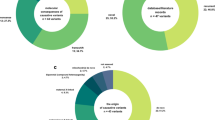Abstract
This study investigated the clinical and genetic characteristics of developmental disorders (DDs) in children attending a rehabilitation department. A total of 94 children with suspected rare and undiagnosed DDs were included in this study. All patients were subjected to next-generation sequencing by means of proband single whole-exome sequencing (Pro-WES) or trio whole-exome sequencing (Trio-WES). To investigate the copy number variations (CNVs), 63 patients were subjected to the trio strategy, and 17 cases were subjected to the proband single strategy. The patients developed early and suffered from severe symptoms. WES reached a high diagnostic rate (48.7%, 46/94), and de novo (48.3%, 28/58) was the main pathogenic form. Most identified single-nucleotide variations (SNVs)/small insertions and deletions (indels) were found only in one patient. The number of uncertain significant locus in the patients taking Trio-WES was significantly lower than that in patients taking Pro-WES (2.1% vs 2.8%). Compared with hereditary mutations passed from parents, pathogenicity was more obvious in de novo mutations. The diagnostic rate of WES accompanied by CNVseq (57.5%, 46/80) was significantly higher (p = 0.016) than WES alone. Next-generation sequencing exhibited a satisfactory diagnostic rate for DDs patients in the rehabilitation department. Compared with the proband-only model, the family trio strategy should be employed more frequently because it can reduce the number of uncertain significant sites and help to identify de novo pathogenic mutations.




Similar content being viewed by others
Availability of Data and Materials
The data for present study are available from the corresponding authors upon reasonable request.
References
Bellman M, Byrne O, Sege R (2013) Developmental assessment of children. Bmj. 346:e8687. https://doi.org/10.1136/bmj.e8687
Bennabi D, Vandel P, Papaxanthis C, Pozzo T, Haffen E (2013) Psychomotor retardation in depression: a systematic review of diagnostic, pathophysiologic, and therapeutic implications. Biomed Res Int 2013:158746. https://doi.org/10.1155/2013/158746
Bowling KM, Thompson ML, Amaral MD, Finnila CR, Hiatt SM, Engel KL et al (2017) Genomic diagnosis for children with intellectual disability and/or developmental delay. Genome Medicine 9(1):43. https://doi.org/10.1186/s13073-017-0433-1
Conners FA, Rosenquist CJ, Arnett L, Moore MS, Hume LE (2008) Improving memory span in children with down syndrome. Journal of Intellectual Disability Research : JIDR 52(Pt 3):244–255. https://doi.org/10.1111/j.1365-2788.2007.01015.x
Cooper GM, Coe BP, Girirajan S, Rosenfeld JA, Vu TH, Baker C et al (2011) A copy number variation morbidity map of developmental delay. Nat Genet 43(9):838–846. https://doi.org/10.1038/ng.909
Franz DN, Belousova E, Sparagana S, Bebin EM, Frost M, Kuperman R et al (2013) Efficacy and safety of everolimus for subependymal giant cell astrocytomas associated with tuberous sclerosis complex (EXIST-1): a multicentre, randomised, placebo-controlled phase 3 trial. Lancet. 381(9861):125–132. https://doi.org/10.1016/S0140-6736(12)61134-9
Gambin T, Akdemir ZC, Yuan B, Gu S, Chiang T, Carvalho CMB et al (2017) Homozygous and hemizygous CNV detection from exome sequencing data in a Mendelian disease cohort. Nucleic Acids Res 45(4):1633–1648. https://doi.org/10.1093/nar/gkw1237
Gao C, Wang X, Mei S, Li D, Duan J, Zhang P et al (2019) Diagnostic yields of trio-WES accompanied by CNVseq for rare neurodevelopmental disorders. Front Genet 10:485. https://doi.org/10.3389/fgene.2019.00485
Jiao Q, Sun H, Zhang H, Wang R, Li S, Sun D et al (2019) The combination of whole-exome sequencing and copy number variation sequencing enables the diagnosis of rare neurological disorders. Clin Genet 96(2):140–150. https://doi.org/10.1111/cge.13548
Kadalayil L, Rafiq S, Rose-Zerilli MJ, Pengelly RJ, Parker H, Oscier D et al (2015) Exome sequence read depth methods for identifying copy number changes. Brief Bioinform 16(3):380–392. https://doi.org/10.1093/bib/bbu027
Kearney HM, Thorland EC, Brown KK, Quintero-Rivera F, South ST (2011) Working Group of the American College of medical genetics laboratory quality assurance C. American College of Medical Genetics standards and guidelines for interpretation and reporting of postnatal constitutional copy number variants. Genetics in Medicine : Official Journal of the American College of Medical Genetics 13(7):680–685. https://doi.org/10.1097/GIM.0b013e3182217a3a
Li MM, Datto M, Duncavage EJ, Kulkarni S, Lindeman NI, Roy S et al (2017) Standards and guidelines for the interpretation and reporting of sequence variants in Cancer: a joint consensus recommendation of the Association for Molecular Pathology, American Society of Clinical Oncology, and College of American Pathologists. The Journal of Molecular Diagnostics : JMD 19(1):4–23. https://doi.org/10.1016/j.jmoldx.2016.10.002
Li M, Xu Y, Wang Y, Yang XA, Jin D (2019) Compound heterozygous variants in MOGS inducing congenital disorders of glycosylation (CDG) IIb. J Hum Genet 64(3):265–268. https://doi.org/10.1038/s10038-018-0552-6
Luiz D, Barnard A, Knoesen N, Kotras N, Horrocks S, McAlinden P et al (2006) Griffiths mental development scales-extended revised. Two to eight years. Administration manua. Hogrefe, Oxford
Majnemer A, Shevell MI (1995) Diagnostic yield of the neurologic assessment of the developmentally delayed child. J Pediatr 127(2):193–199. https://doi.org/10.1016/s0022-3476(95)70294-6
Miller DT, Adam MP, Aradhya S, Biesecker LG, Brothman AR, Carter NP et al (2010) Consensus statement: chromosomal microarray is a first-tier clinical diagnostic test for individuals with developmental disabilities or congenital anomalies. Am J Hum Genet 86(5):749–764. https://doi.org/10.1016/j.ajhg.2010.04.006
Naismith S, Hickie I, Ward PB, Turner K, Scott E, Little C et al (2002) Caudate nucleus volumes and genetic determinants of homocysteine metabolism in the prediction of psychomotor speed in older persons with depression. Am J Psychiatry 159(12):2096–2098. https://doi.org/10.1176/appi.ajp.159.12.2096
Soden SE, Saunders CJ, Willig LK, Farrow EG, Smith LD, Petrikin JE et al (2014) Effectiveness of exome and genome sequencing guided by acuity of illness for diagnosis of neurodevelopmental disorders. Sci Transl Med 6(265):265ra168. https://doi.org/10.1126/scitranslmed.3010076
Tan R, Wang Y, Kleinstein SE, Liu Y, Zhu X, Guo H et al (2014) An evaluation of copy number variation detection tools from whole-exome sequencing data. Hum Mutat 35(7):899–907. https://doi.org/10.1002/humu.22537
Tang M, Wang Y, Xu Y, Tong W, Jin D, Yang XA (2020) IDDCA syndrome in a Chinese infant due to GNB5 biallelic mutations. J Hum Genet. https://doi.org/10.1038/s10038-020-0742-x
Tong W, Wang Y, Lu Y, Ye T, Song C, Xu Y et al (2018) Whole-exome sequencing helps the diagnosis and treatment in children with neurodevelopmental delay accompanied unexplained dyspnea. Sci Rep 8(1):5214. https://doi.org/10.1038/s41598-018-23503-2
Tso WWY, Wong VCN, Xia X, Faragher B, Li M, Xu X et al (2018) The Griffiths development scales-Chinese (GDS-C): a cross-cultural comparison of developmental trajectories between Chinese and British children. Child Care Health Dev 44(3):378–383. https://doi.org/10.1111/cch.12548
Vernon H, Cohen J, De Nittis P, Fatemi A, McClellan R, Goldstein A, et al (2018) Intellectual developmental disorder with cardiac arrhythmia syndrome in a child with compound heterozygous GNB5 variants. 93(6):1254–6. https://doi.org/10.1111/cge.13194
Wright CF, Fitzgerald TW, Jones WD, Clayton S, McRae JF, van Kogelenberg M et al (2015) Genetic diagnosis of developmental disorders in the DDD study: a scalable analysis of genome-wide research data. Lancet. 385(9975):1305–1314. https://doi.org/10.1016/S0140-6736(14)61705-0
Zhang F, Gu W, Hurles ME, Lupski JR (2009) Copy number variation in human health, disease, and evolution. Annu Rev Genomics Hum Genet 10:451–481. https://doi.org/10.1146/annurev.genom.9.081307.164217
Zhang Y, Yu Z, Ban R, Zhang H, Iqbal F, Zhao A et al (2015) DeAnnCNV: a tool for online detection and annotation of copy number variations from whole-exome sequencing data. Nucleic Acids Res 43(W1):W289–W294. https://doi.org/10.1093/nar/gkv556
Funding
This study was supported by Initial Scientific Research Fund for High-Level Talents of Chengde Medical University (No.201901), Scientific and Technological Research Projects of Hebei Higher Education (No. ZD2019084), National Natural Science Foundation of China (No.31700897), Yunnan Provincial Natural Science Foundation of China (No.2018FB053), and China Postdoctoral Science Foundation (No.2018 M631105).
Author information
Authors and Affiliations
Corresponding authors
Ethics declarations
Conflict of Interest
The authors declare that the research was conducted in the absence of any commercial or financial relationships that could be construed as a potential conflict of interest.
Additional information
Publisher’s Note
Springer Nature remains neutral with regard to jurisdictional claims in published maps and institutional affiliations.
Electronic supplementary material
Supplementary Table 1
Detailed information on demographics and phenotypic abnormalities according to The Human Phenotype Ontology. (XLSX 24 kb)
Supplementary Table 2
Information of NGS strategy and WES results for this cohort. (XLSX 16 kb)
Supplementary Table 3
Rare CNVs identified by CNVseq in this study. (DOCX 16 kb)
Rights and permissions
About this article
Cite this article
Liu, Y., Liu, X., Qin, D. et al. Clinical Utility of Next-Generation Sequencing for Developmental Disorders in the Rehabilitation Department: Experiences from a Single Chinese Center. J Mol Neurosci 71, 845–853 (2021). https://doi.org/10.1007/s12031-020-01707-4
Received:
Accepted:
Published:
Issue Date:
DOI: https://doi.org/10.1007/s12031-020-01707-4




